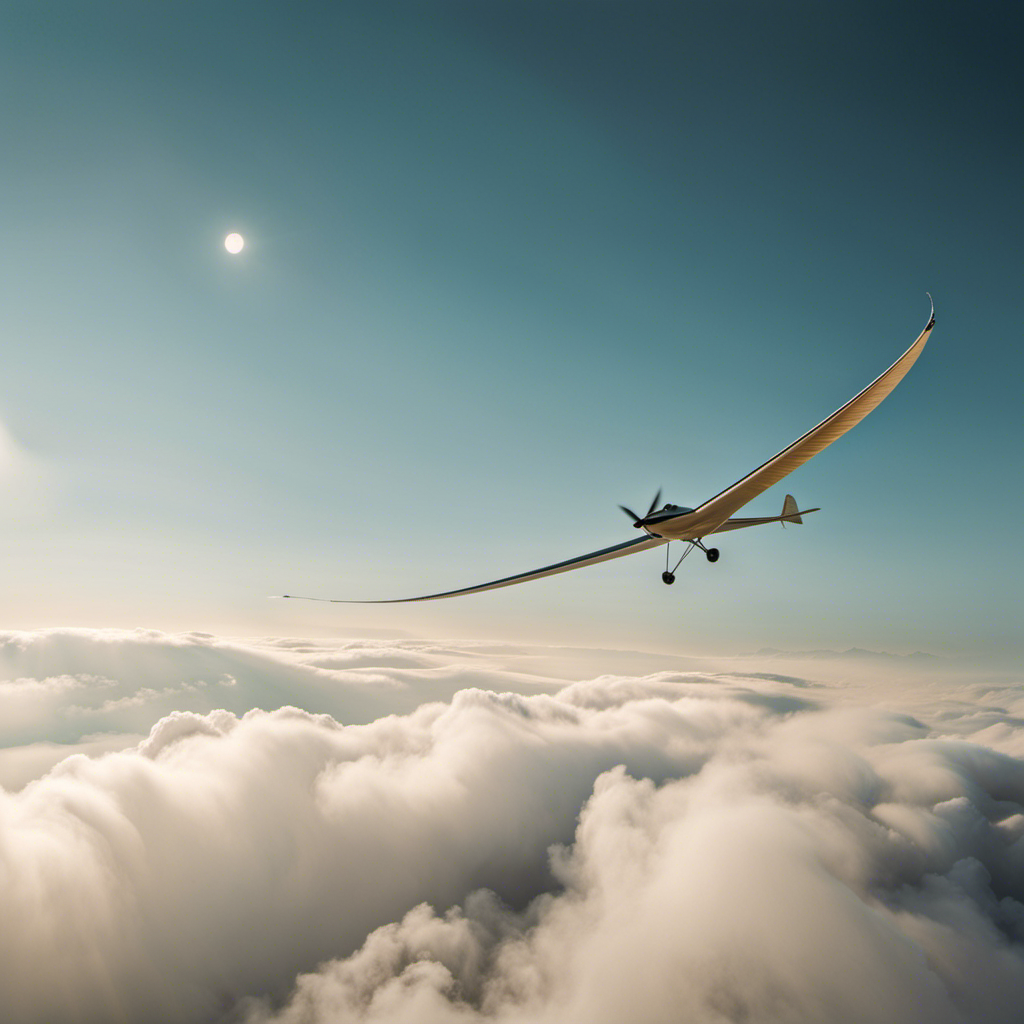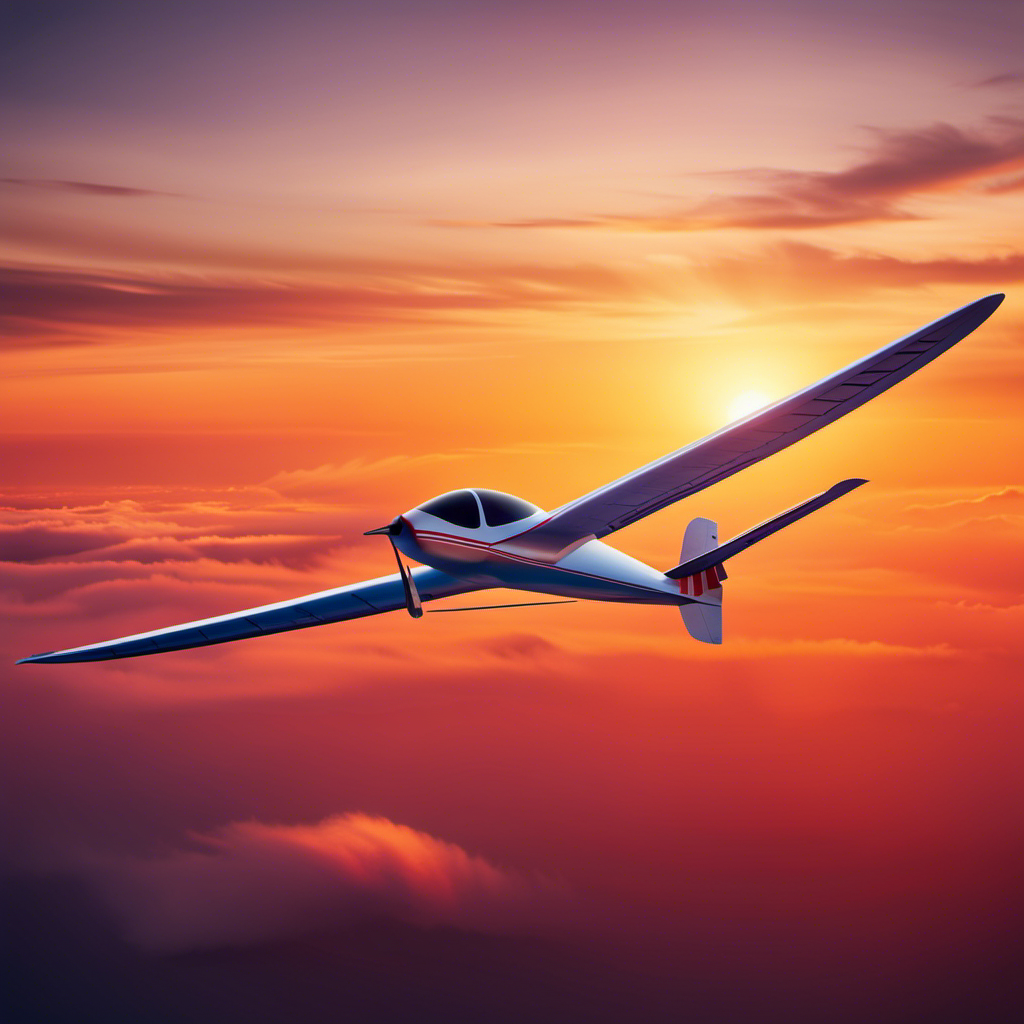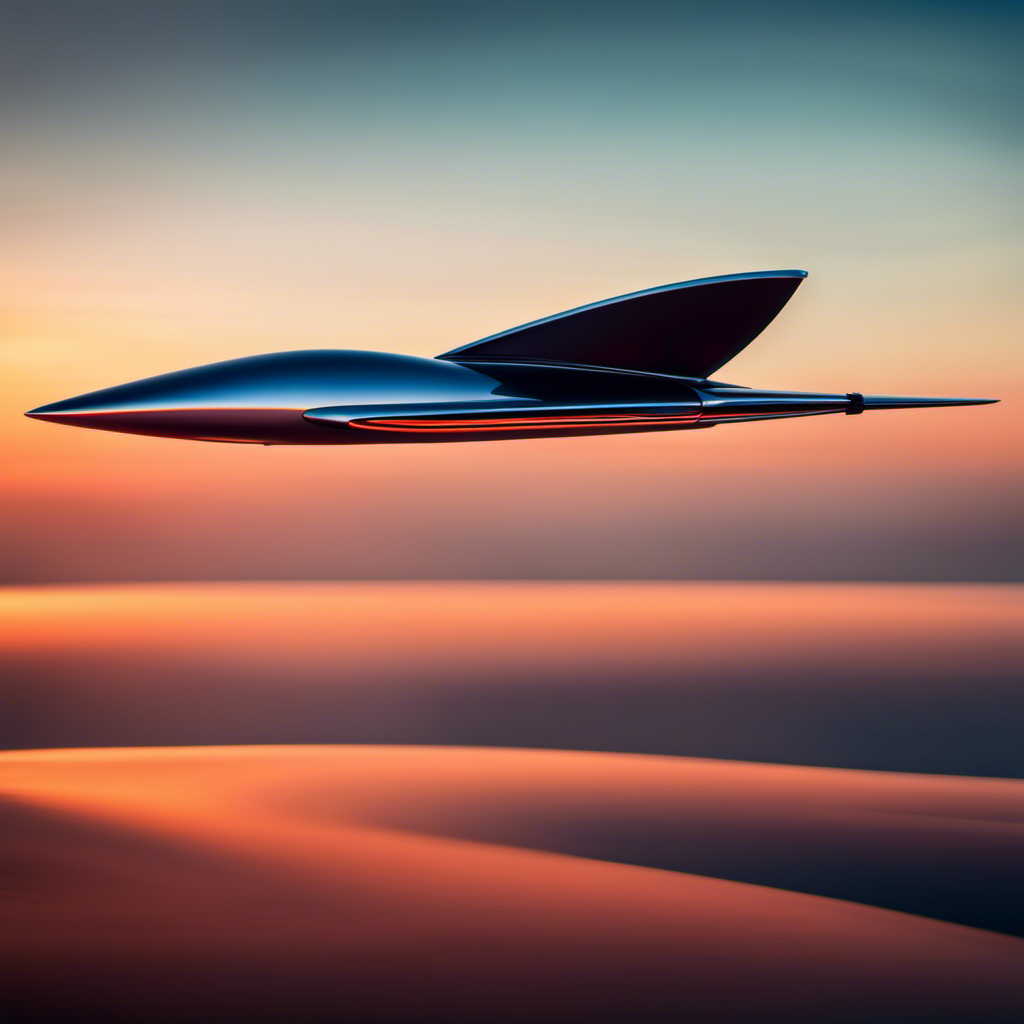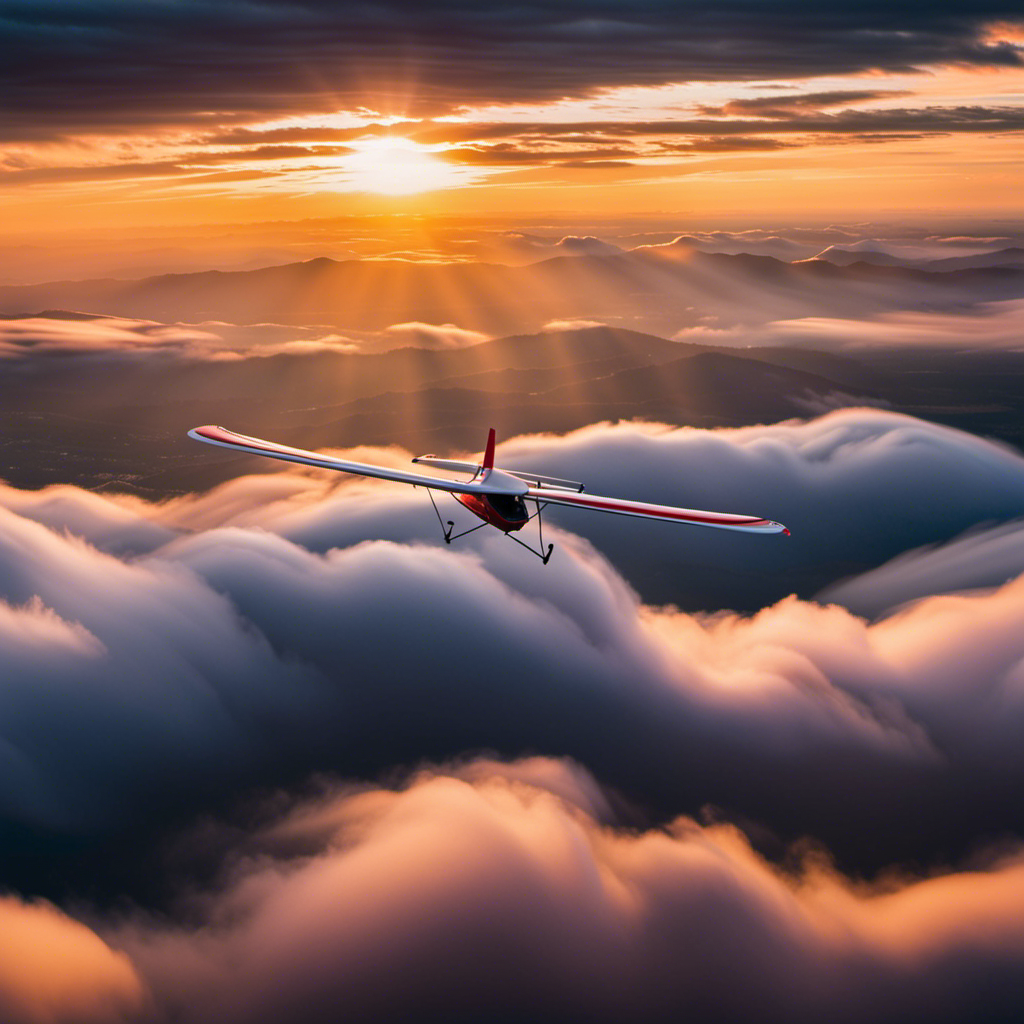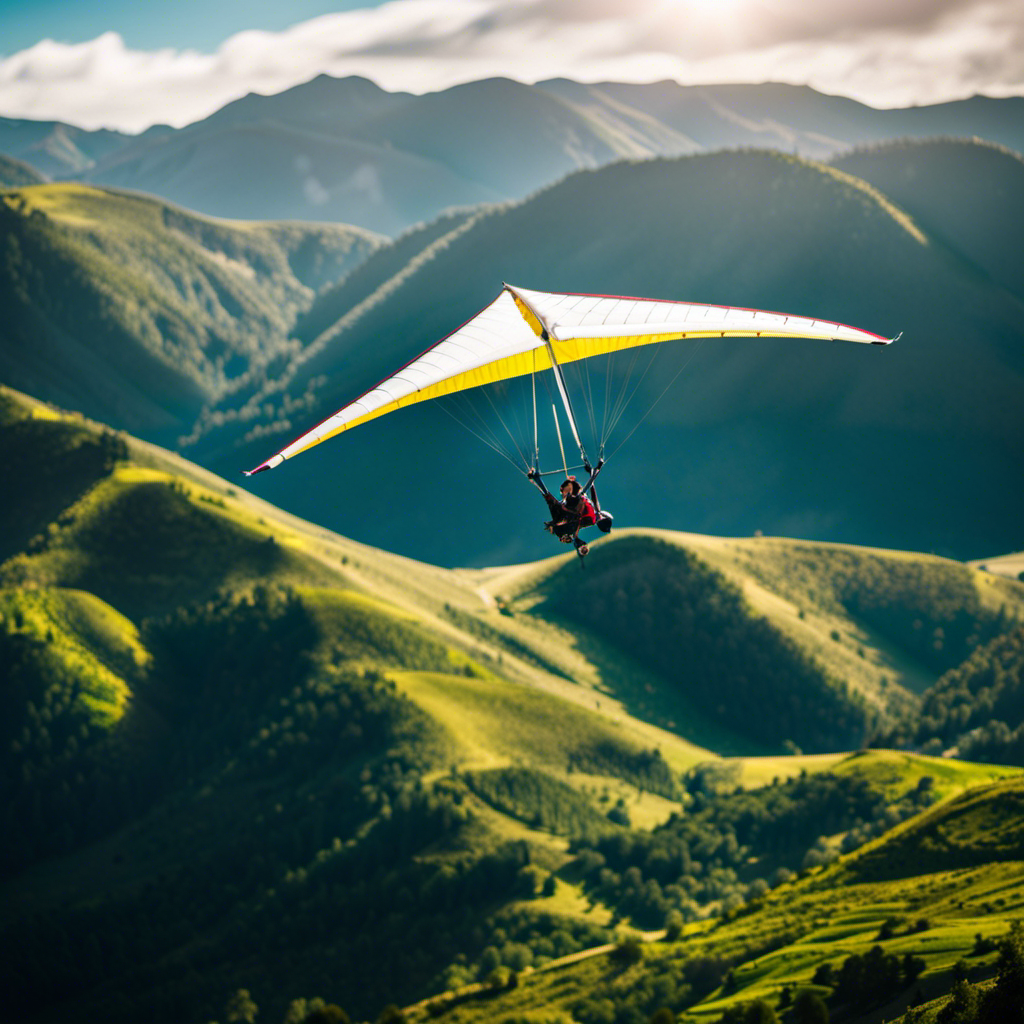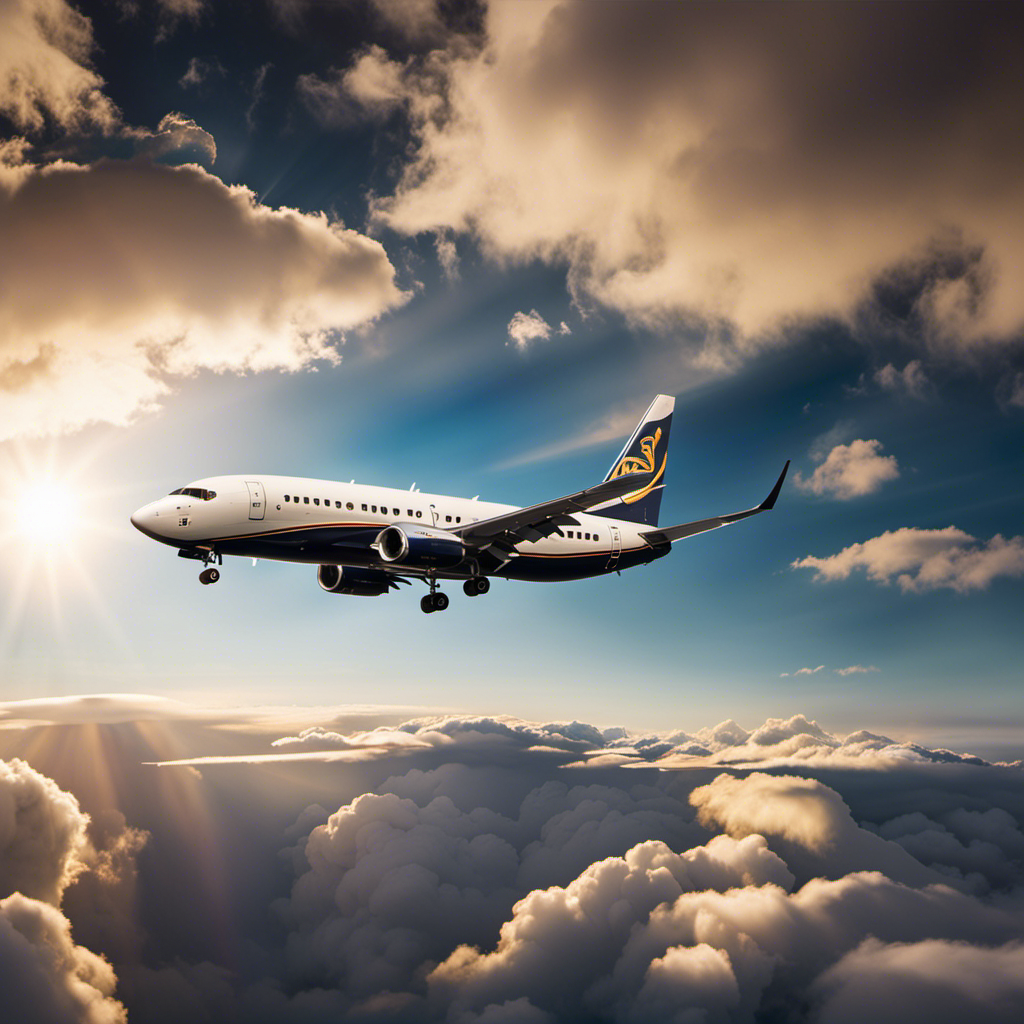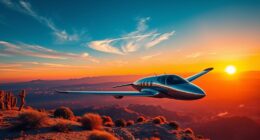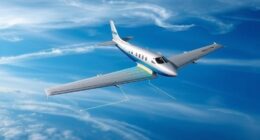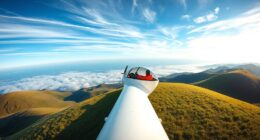Flying high in the endless skies, I am captivated by a question that lingers in the minds of glider enthusiasts around the world: What is the longest amount of time gliders can stay in the air?
In this article, we will delve into the intricacies of gliding, exploring the fundamental principles of lift and the techniques employed to maximize flight duration.
We will also examine the various factors that influence glider flight, from weather conditions to pilot skill.
Join me on this journey as we unlock the secrets behind the remarkable endurance of these graceful flying machines.
Key Takeaways
- Glider flight technology advancements have allowed for longer journeys and exploration of new horizons.
- Safety measures such as regular maintenance checks, weather monitoring, and emergency protocols are crucial for extended glider flights.
- Gliding competitions and events are influenced by glider design innovations, achieving greater speeds, and sustainable practices.
- Training and certification ensure glider pilots have the necessary skills and knowledge to participate safely in competitions and events.
The Basics of Gliding
The basics of gliding are simple: you can stay in the air for hours without an engine. Understanding glider aerodynamics and flight techniques is essential to achieving this feat.
Glider aerodynamics involve the study of forces acting on the aircraft, such as lift, drag, and gravity. Lift is the force that counteracts gravity and keeps the glider airborne. To generate lift, glider pilots use various flight techniques, including adjusting the glider’s angle of attack, controlling airspeed, and utilizing thermals or updrafts.
These techniques allow the glider to maintain altitude and even gain height without the need for an engine. By understanding glider aerodynamics and mastering flight techniques, glider pilots can maximize their time in the air, setting the stage for exploring lift and soaring techniques.
Understanding Lift and Soaring Techniques
To understand lift and soaring techniques, you’ll need to grasp the fundamental principles behind staying aloft in a glider. Soaring is the art of using natural sources of lift to maintain and increase altitude, allowing gliders to stay in the air for extended periods.
Here are the key elements of lift analysis and soaring techniques:
-
Thermals: These are columns of warm rising air created by the sun heating the ground. Glider pilots search for thermals and circle within them to gain altitude.
-
Ridge Lift: When wind encounters a mountain or ridge, it is forced upward, creating a lift. Pilots can use this lift to stay aloft by flying along the ridge.
-
Wave Lift: In certain weather conditions, strong winds can create standing waves in the atmosphere. Gliders can ride these waves to gain significant altitude.
-
Dynamic Soaring: This technique involves exploiting the difference in wind speed between two layers of air, allowing the glider to gain energy and maintain altitude.
Understanding these soaring techniques and lift analysis is crucial for maximizing the duration of glider flights. By utilizing these principles effectively, pilots can extend their time in the air and explore the factors that affect glider flight duration, such as weather conditions and pilot skill.
Factors Affecting Glider Flight Duration
Factors like weather conditions and pilot skill play a crucial role in how long glider flights can last.
Weather factors such as wind strength, direction, and thermal activity determine the availability of lift, which is essential for sustaining flight.
Pilots employ various strategies to maximize flight duration, including choosing the right time of day when thermal activity is at its peak, selecting the most favorable wind direction for ridge soaring, and carefully planning flight routes to take advantage of known thermal sources.
Skillful piloting techniques, such as efficient energy management and precise control inputs, also contribute to extended flight times.
By carefully monitoring weather conditions, employing effective strategies, and continuously honing their skills, glider pilots can achieve impressive flight durations.
Transitioning into the next section, world records for glider flight duration highlight the extraordinary achievements in this field.
World Records for Glider Flight Duration
Impressive achievements in this field include world records for how long you can keep a glider in the air. These records highlight the incredible capabilities of gliders and the skill of the pilots who operate them. Here are four remarkable world records for glider flight duration:
-
The current world record stands at 56 hours and 15 minutes, achieved by Klaus Ohlmann in 2003. He utilized powerful thermals and skillfully navigated weather patterns to stay aloft for an extraordinary length of time.
-
In 2012, Steve Fossett set a record of 76 hours and 45 minutes. Fossett strategically exploited wave lift, a phenomenon where the glider gains altitude from mountainous air currents, allowing him to soar for days.
-
Another notable record was set by Einar Enevoldson in 2013, who flew for 56 hours and 15 minutes. Enevoldson made use of polar jet streams, high-altitude winds that can propel gliders to incredible speeds and heights.
-
In 2018, Klaus Ohlmann broke his own record, staying airborne for an astounding 72 hours and 3 minutes. This feat required meticulous planning, precise execution, and a deep understanding of atmospheric conditions.
These world records demonstrate the immense potential for glider flight duration and serve as inspiration for exploring strategies to extend glider flight time without compromising safety or efficiency.
Strategies for Extending Glider Flight Time
By utilizing various techniques and harnessing natural forces, pilots can significantly prolong the duration of their glider flights.
One key strategy for extending flight time is improving aerodynamics. This involves reducing drag by streamlining the glider’s shape, minimizing protrusions, and using smooth surfaces. By optimizing the glider’s design, pilots can increase its efficiency and glide ratio, allowing it to travel farther with each unit of altitude lost.
Another crucial technique is maximizing thermal energy. Thermals are rising columns of warm air that gliders can use to gain altitude. By skillfully locating and exploiting these thermals, pilots can stay aloft for extended periods, riding the invisible currents of warm air.
These strategies, when combined, enable pilots to achieve impressive flight durations. However, advancements in glider flight technology have further revolutionized the possibilities for extended flights.
Technology Advancements in Glider Flight
Advancements in glider flight technology have revolutionized the possibilities for extended flights, allowing pilots to achieve longer durations in the air. These advancements have been driven by continuous innovation in various aspects of glider design and engineering.
One key area of advancement is in the materials used for constructing gliders. Lightweight and strong materials like carbon fiber composites have replaced traditional materials, reducing the overall weight of the glider and improving its aerodynamic efficiency.
Additionally, advancements in wing design have led to the development of high aspect ratio wings, which generate more lift and reduce drag, enabling gliders to stay aloft for longer periods of time. Other innovations include the incorporation of advanced instruments and avionics systems that provide pilots with real-time data on weather conditions, thermals, and air traffic, optimizing flight planning and maximizing flight time.
These advancements in glider flight technology have significantly increased the potential for extended flights, pushing the boundaries of what was once thought possible.
By leveraging these technological advancements, pilots can now embark on longer journeys and explore new horizons. However, it is important to acknowledge that with these extended flights come challenges and risks. The longer a glider remains in the air, the more factors come into play, such as changing weather conditions, fatigue, and navigation complexities.
These challenges require pilots to be highly skilled and well-prepared, as even minor mistakes can have severe consequences. Additionally, the risk of encountering unexpected turbulence or downdrafts increases with longer flight durations, necessitating constant vigilance and the ability to make quick and accurate decisions.
Therefore, while advancements in glider flight technology have opened up new possibilities, pilots must always be mindful of the inherent risks and challenges that come with extended flights.
Challenges and Risks in Glider Flight
Navigating changing weather conditions and potential turbulence can pose significant challenges and risks for pilots during extended glider flights. To ensure the safety of both the aircraft and the pilot, several measures need to be taken. These include:
-
Regular maintenance checks: Gliders require meticulous maintenance to ensure that all components are in optimal condition. Any overlooked issues could lead to potential failures during flight.
-
Weather monitoring: Pilots must constantly monitor the weather conditions to anticipate any changes that may affect the flight. This includes keeping an eye on wind patterns, cloud formations, and temperature fluctuations.
-
Emergency protocols: Pilots must be well-versed in emergency procedures and have a thorough understanding of how to handle unexpected situations. This includes practicing emergency landings and knowing how to navigate through turbulent weather conditions.
By implementing these safety measures, pilots can mitigate the challenges and risks associated with extended glider flights. This ensures that both the aircraft and the pilot remain safe throughout their journey.
Transitioning into the subsequent section about gliding competitions and events, it is important to note that these safety measures become even more crucial in high-stakes situations.
Gliding Competitions and Events
To fully immerse yourself in the world of gliding competitions and events, it’s important to understand the different categories and scoring systems used to evaluate pilots’ performances.
Glider design innovations have played a crucial role in enhancing the performance of gliders in these competitions. From improved aerodynamics to lighter materials, these innovations have allowed pilots to achieve greater speeds, longer flights, and more precise maneuverability.
However, it’s also important to consider the environmental impact of glider competitions. While gliders themselves are relatively eco-friendly, the events can still have an impact on local ecosystems and air quality. Measures are being taken to minimize this impact, such as using electric tow planes and implementing sustainable practices at competition sites.
Transitioning into the next section about training and certification for glider pilots, developing the necessary skills and knowledge in this field is essential for ensuring safe and successful participation in gliding competitions and events.
Training and Certification for Glider Pilots
Developing the necessary skills and knowledge in this field is essential for ensuring safe and successful participation in gliding competitions and events. As a glider pilot, I understand the importance of rigorous training techniques and safety measures to maintain the highest level of proficiency.
Here are three key aspects of training and certification for glider pilots:
-
Extensive Ground School: This includes theoretical instruction on aerodynamics, meteorology, navigation, and emergency procedures. Understanding these concepts is crucial for making informed decisions while in the air.
-
Practical Flight Training: Pilots undergo hands-on training to learn the specific maneuvers and techniques required for glider flight. This includes takeoffs, landings, soaring techniques, and emergency procedures.
-
Safety Briefings and Regulations: Glider pilots must adhere to strict safety guidelines and regulations. Regular safety briefings are conducted to ensure pilots are aware of the latest safety measures and best practices.
With these comprehensive training techniques and safety measures in place, glider pilots can confidently navigate the skies.
Looking ahead, the future of glider flight holds exciting possibilities for advancements in technology and efficiency.
The Future of Glider Flight
As a glider pilot, you can expect exciting advancements in technology and increased efficiency in the future of glider flight. The glider industry is constantly evolving, with future innovations focusing on improving both performance and sustainability.
One area of development is in the materials used for constructing gliders. Lightweight and strong composite materials are being researched and tested, which will enhance the glider’s aerodynamic capabilities and improve its overall efficiency.
Additionally, advancements in energy storage and propulsion systems will enable gliders to stay airborne for longer durations, maximizing flight time and reducing the need for traditional energy sources.
These future innovations not only enhance the glider pilot’s experience but also have a positive environmental impact by reducing the carbon footprint associated with glider flight.
Frequently Asked Questions
What are some common glider flight maneuvers?
In thermal soaring, gliders use rising columns of warm air called thermals to gain altitude. This allows them to stay in the air for extended periods. In ridge soaring, gliders use the upward wind created by a ridge or mountain to stay aloft.
How much does a glider cost to purchase?
Glider insurance and maintenance costs can vary depending on factors like the glider’s value, location, and pilot experience. To purchase a glider, you can expect to spend anywhere from $10,000 to $200,000.
Are there any age restrictions for glider pilots?
There are age restrictions for glider pilots. In order to fly a glider, one must meet certain pilot qualifications. These qualifications ensure that pilots have the necessary skills and knowledge to operate a glider safely.
Can gliders fly at night?
Gliders can fly at night, but there are specific restrictions and safety considerations. Night flying requires proper lighting, navigation equipment, and adherence to airspace regulations. It is crucial to ensure the safety of both the glider and other aircraft.
Are there any restrictions on where gliders can fly?
There are restrictions on where gliders can fly due to restricted airspace and glider flight regulations. These regulations ensure the safety of glider pilots and other aircraft by defining areas where gliders are not permitted to fly.
Conclusion
In conclusion, gliding is an exhilarating sport that offers the thrill of soaring through the skies with the power of the wind.
By understanding lift and employing effective soaring techniques, glider pilots can extend their flight duration and even break world records.
However, it is important to note that glider flight is not without its challenges and risks. With proper training and certification, pilots can navigate these challenges and participate in gliding competitions and events.
As the future of glider flight unfolds, advancements in technology and techniques will continue to push the boundaries of what is possible in the air.
So, strap in and get ready for an unforgettable gliding experience!
